Glossary of Lichen terms
Growth types. A B C D E F G H I J K L M N O P Q R S T U V W X Y Z Fruiting bodies (apothecia).
A
Acid bark. Bark of trees with relatively low PH e.g Oak, Beech, Birch
Acid rocks. Siliceous rocks. Not reacting to hydrochloric acid.
Adpressed. Flat, pressed close to the substratum
Apical. At the tip or apex.
Apothecium(ia). Disc-shaped or elongated fruiting body that contains the ascus(i)
Areole. Island formed by cracks in thallus. Areolate. Cracked thallus formed by coalescence of separate aureoles.
Arthonioid. Type of fruiting body without a true margin.
Ascospore. Reproductive body of the fungus, formed within an ascus(i) (sac-like cell containing ascospores)
Asexual. Reproducing and dispersing vegetatively
B
Basic bark. Bark of trees with relatively high PH e.g Sycamore, Maple, Elm
Basidiomycete. Fungus with spores on a club-shaped basidium rather than in an ascus
Biatorine. Type of apothecium without proper margin. Pale, soft and +/- convex when mature.
Blastidium(ia). Rounded, vegetative lichen propagule containing both partners.
Bullate. With convex, blister-like swellings
C
Calcareous. Rock or soil with high proportion of calcium carbonate e.g chalk, limestone. Alkaline, reacts to hydrochloric acid.
Canaliculate. Trough-shaped or channelled.
Carbonaceous. Hard, black, opaque, often friable. Carbonised. Tissue with black, opaque pigment
Cephalodium. Internal or external part of thallus containing a photobiont different from that of the rest of the thallus.
Chemotypes. Members of a species differing in their chemical constituents.
Cilia. Long marginal or submarginal hair-like growths
Concolorous. Of the same colour.
Conidium(ia). Asexually produced fungal spore
Coralloid. Branched like coral or thin and pencil-like
Cortex. Outer layers of the thallus, consists of tightly woven fungal hyphae. Corticate.
Having a thallus.
Corticolous. Growing on wood
Crenulate. The edge with more/less regular notches.
Crustose. Crust-like thallus type, can't usually be removed from substratum without damage. Sometimes immersed.
Cyanobacteria. Previously known as 'blue-green' algae.
Cyphella(ae). Regular round or ovate perforations through the lower cortex.
D
![]() Return to Top
Return to Top
Decorticate. Areas where the cortex is missing
Decumbent. Flat on the subsratum with ends up-turned
Delimited. With clearly defined borders
Dentate. Tooth-like
Dichotomous. Forked or divided into two
Digitate. With finger-like projections
Disc. The central upper surface of the apothecia, inside the margins
Discrete. In separate patches
Dorsiventral. Lower and upper surfaces differing in appearance
E
Ecotype. A species showing consistent variation caused by or in response to, its habitat
Effuse. Spread thinly, spreading growth without clear margins
Endemic. Occurs only in a single, often small, geographic area
Endolithic. Saxicolous lichens growing within the rock. Epilithic. Saxicolous lichens growing on thr surface of the rock.
Epidermis. Outer cell layer of leaves and young twigs
Epiphytic. Growing non-parasitically on plants (usually but not always, on woody species)
Epithecium(ia). Upper layer of hymenium above the asci, consists of apices of the paraphyses in an (often coloured) gelatinous substance
Erumpent. Bursting through the surface
Evanescent. Short-lived, disappearing early
Exciple (excipulum). Tissue forming margins or walls of an ascoma.
F
Farinose. Flour-like
Fascicle. Small group or bundle
Fibrils. Short simple branches growing perpendicular to main branches (of Usnea)
Filamentous. Lichen thallus type with thread-like photobiont surrounded by hyphae or mycobiont cells
Fimbriate. Fringed or finely toothed.
Flexuose. Wavy or twisted.
Foliole. Small leaf-like structure on the thallus of foliose lichens
Foliose. Leaf-like thallus growth form.
Fruticose. Shrubby or beard-like thallus growth form. Branches rounded or flattened, no distinct upper and lower surfaces. Attached to substrate by only one point or unattached
Furcate. Divided into two branches, forked
G
![]() Return to Top
Return to Top
Glabrous. Smooth
Glaucous. Pale bluish-grey
Globose. Spherical or nearly spherical
Goniocyst. Minute round propagule formed of cells wrapped in fungal hyphae
Gyrose. Folded circularly, with infolded margins
H
Hamethecium. Tissues separating the asci in the fruiting body
Hapters. Sucker-like mass of adhesive hyphae attaching some lichens to the substratum
Holdfast. Root-like structure attaching some lichens to the substratum
Hypha(ae). Fungal filament
Hyphomycete. Asexually reproducing group of fungi
Hypothallus. Dark felted under-surface comprised of a layer of fungal tissue without photobiont cells
Hypothecium. Layer below the thecium
I
Imbricate. Overlapping
Immarginate. Without a clearly defined margin
Immersed / Innate. Fruiting bodies more/less within the thallus or substratum
Incised. Cut
Index of Ecological Continuity (IEC). The percentage of 20 selected old-forest indicator species that occur in a particular site
Involucrellum. External cover of some perithecia, surrounding and distinct from the exciple
Involute. Margins rolled in
Isidiose. With the appearance of isidia
Isidium(ia). Tiny detachable outgrowths containing both fungal and algal cells for vegetative dispersal.
Isolichen. Starch-like substance produced by some lichens
L
![]() Return to Top
Return to Top
Lacerate. Margins irregularly torn or cut
Laminal. On the surface of the lobes
Lax. Loose, flexible
Lecanoride. Apothecium with a thalline margin similar to the thallus
Lecideine. Apothecium with a proper margin of a different colour to the thallus
Leprose. Thallus comprised of powdery mass of algal and hypal cells without a cortex
Lichenicolous. Growing on lichens
Lichenometry. Measurement of lichen growth that is used as a technique for dating rock surfaces
Lignicolous. Growing on cut or exposed wood, not on bark, (corticolous)
Lirella(ae). Narrow elongated apothecium, usually with carbonaceous margin
Littoral. Area of seashore regularly submerged by tide, dominated by marine algae and
barnacles.
Lobate. Lobed
Lobulate. With small lobes
M
Maculate. Blotched, patchy or spotted
Marginate. With clearly defined edge
Medulla. Inner part of thallus below the cortex and algal layer. Usually comprised of loosely packed fungal hyphae
Mesic-supralittoral. Wettest part of the supralittoral (seashore) zone, occasionally splashed by waves
Metallophytes. Species confined to substrata with very high heavy metal contents
Microhabitat. Ecological niche within a larger habitat e.g the lower surface of a rock, a bark crevice
Morph. Particular form or shape produced by different stimuli
Mucronate. Ending in short, sharp point
Muscicolous. Growing on or over moss
Mycobiont. The fungal partner
N
Necral. Of dead tissue, white, granular appearance
Neutrophilous. Prefers neutral or basic surfaces
Nitrophilous Prefers nitrogen-rich substratum
Nutrient-enriched. Substratum enriched by fertilizer, bird droppings, etc
Nutrient-rich. Usually refers to bark that is rich in basic compounds, non-acidic
O
![]() Return to Top
Return to Top
Obligate. Restricted to a particular substratum, host or method of nutrition
Obtuse. Branching at a wide angle or having rounded ends
Oceanic. The damp, mild west coasts of Ireland and Britain
Old-forest indicator species. Species that are characteristic of woods and forests with long continuity of mature trees. Used in calculation of Index of Ecological Continuity
Oligotrophic A body of water that is poor in nutrients
Orbiculate. Circular outline
Ostiole. The opening at the top of a perithecium
Ovate. Egg-shaped
P
Palmate. Shaped like the palm of a hand
Papilla(ae). Small finger-like or or wart-like protuberance
Peltate. Plate-like with short stalk from centre of lower surface
Perispore. Colourless layer surrounding the spore wall
Perithecium(ia). Flask-shaped or sub-globose fruiting body. Hymenium not exposed
Photobiont. Photosynthesising partner, can be green algae or a cyanobacterium (blue-green algae)
Phyllocladia. Small leaf-like lobes
Pioneer species. First species to establish themselves on a substratum
Placodioid. Crustose lichen with lobed margins
Plicate. Folded into pleats
Podetium (ia). Lichenised stem of a fruiting body arising from a squamulose, granular or evanescent primary thallus
Polyphyllus. Multi-lobed
Poriform. Pore-like
Propagule. Reproductive or dispersal body containing both photobiont and mycobiont
Proper margin. Margin of disc containing fungal but not algal cells. Often concolorous with disc.
Prostrate. Flattened
Prothallus. Area round edge of crustose thallus not containing algal cells
Pruina. Fine flour-like or frost-like covering, often white
Pseodo-. False
Pseodocyphella(ae). Pale line, dot or patch where cortex is thin or absent
Pubescent. With soft hairs
Pulvinate. Cushion-shaped
Punctiform. Small, sharply delimited
Pustulate. Blister-like area or spore-mass
Pycnidium(ia). Flask-shaped body on thallus that produces conidia
Pyriform. Pear-shaped
R
![]() Return to Top
Return to Top
Reniform. Kidney-shaped
Reticulate. Netted, with net-like pattern
Revolute. Lying flat on substatum with margins turned downwards, usually towards apex
Rhizine(ae). Root-like attachment organ from lower cortex
Rimose. Irregularly cracked
Rimose-areolate. Small islands of thallus formed by cracking within thallus
Rugose. Roughened
S
Saccate. Sac-like
Saprobe. Obtaining nutrients from non-living organic matter
Saxicolous. Growing on or inhabiting rocks and stones
Scabrid. Rough and scurfy
Schizidium(ia). Scale-like propagule formed by the flaking off of upper layers of thallus
Scyphus. A podetium in Cladonia species widening at top to form a cup
Septum(a). Internal wall dividing cells or part of cells
Sessile. Without stem or stalk
Siliceous. 'Acidic' rocks with high silicate content, sand, granite, flints, quartzite etc. No reaction to hydrochloric acid
Sinuate. Curved, winding
Soralium(ia). Structure or region of thallus producing soredia
Soredium(ia). Small powdery propagule containing algal cells and fungal hyphae
Spathulate. Spoon-like
Spinule. A small spine
Spore. Fungal reproductive body
Squamule. Small scale-like structure without a lower cortex
Squamulose. Having small scales
Squarrose. Bottle-brush shaped (of rhizines)
Stellate. Star-shaped, radiating
Stipe. Stalk of an ascoma or basidioma
Striate. With +/- parellel lines, grooves or ridges
Subulate. Awl shaped, slender and tapering to a point
ssp. Sub-species
Substrate. Material or medium on or within which an organism grows and usually derives nutrients from
Supra-littoral zone. Area of seashore above the high-tide line which is never submerged but is splashed and receives wind-borne spray
Symbiont. One of two partners living together
Symbiosis. Relationship (usually long-term) between two organisms. Can be mutually beneficial or one partner benefits at the expense of the other
T
![]() Return to Top
Return to Top
Tartareous. With thick, crumbling surface
Terete. More or less circular in section, often narrowing at one end
Terricolous. Lichens growing on soil, sand, peat etc
Tetrachotomous. Divided into four equal branches
Thalline margin. Outer rim of lecanorine apothecia containing both algal and fungal cells. Usually same colour as thallus
Thallus. Vegetative body of lichen, contains both fungal and algal cells
Thecium. Hyphal layers of an apothecium. Comprises the paraphyses, asci and spores
Tholus. The inner apical tissues of many asci
TLC. Thin-layer chromatography, method used to identify chemical substances produced by a lichen
Tomentum(ose). Felt-like mat of hyphae, has the appearance of fine hairs
Trichotomous. Three-branched, divided into three
True exciple. Exciple derived from the ascocarp, usually of different colour to the thallus
Truncate. Ending abruptly
Tubercule. Small wart-like protuberance. Tuberculate. Wart-like
Tumid. Thick and swollen
Turgid. Swollen
U
Umbilicate. Attached only at a central point
Umbo. Raised tissue in centre of apothecia, often sterile. Umbonate. With an umbo
Ulcerose. Ulcer-like
Unciform. Shaped like a hook
Undulate. Wavy
Uniserate. In a single row
Urceolate. Deeply concave, hollow and contorted at margin
V
var. Variety (of a species)
Veins. Strands of tissue on lower side of thallus, often of darker colour than cortex
Verruca. Wart-like swelling. Verrucose. Warted
Verruculose. Delicately warted
X
Xeric-supralittoral. Upper region of supralittoral zone. Receives, at most, only light sea-spray
Return to Top
A
B
C
D
E
F
G
H
I
J
K
L
M
N
O
P
Q
R
S
T
U
V
W
X
Y
Z
GROWTH TYPES:
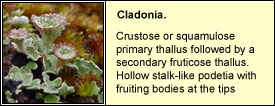
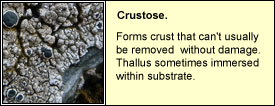
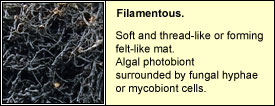
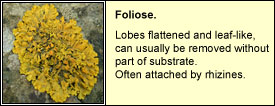
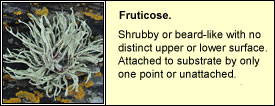
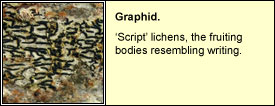
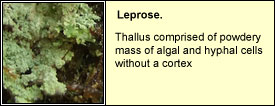
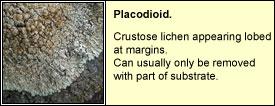
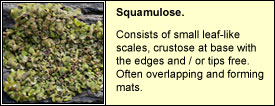
Return to Top
FRUITING BODIES:
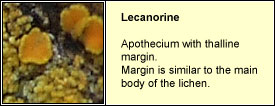
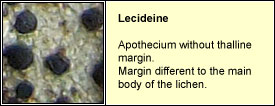
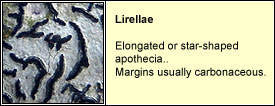
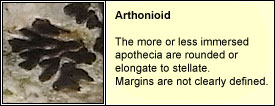
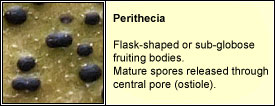
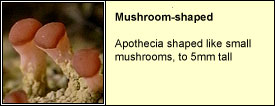
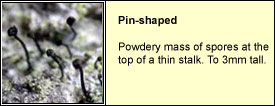
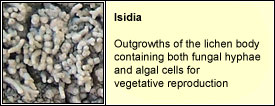
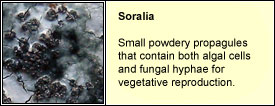
Return to Top
A
B
C
D
E
F
G
H
I
J
K
L
M
N
O
P
Q
R
S
T
U
V
W
X
Y
Z